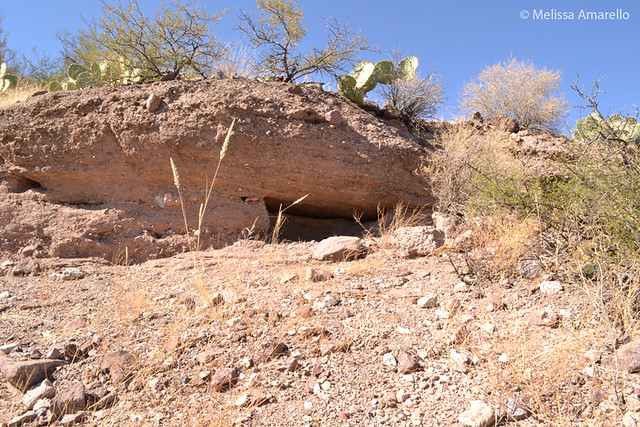
Back in November, we told you about a new snake den in the Galiuro Mountains (Scenes from a new den). We have been monitoring that den with our timelapse cameras ever since. After a relatively quiet winter, activity is really picking up around here. Based on our fall observations, we knew that western diamond-backed rattlesnakes (Crotalus atrox), gila monsters (Heloderma suspectum), Sonoran whipsnakes (Coluber bilineatus), and patch-nosed snakes (Salvadora spp.) visit this den. So we weren't surprised to see this large guy exiting the den on 29 March:
The rattlesnakes have been pretty active at the den's entrance for the past few weeks, so we knew there were a couple male and female diamond-backeds inside. What we did not expect to see was this handsome fellow:
Yeah, that's an Arizona black rattlesnake (Crotalus cerberus). The other Arizona black rattlesnakes we're monitoring here are just emerging from their dens and none have moved away yet, so its highly unlikely this guy just showed up at this spot. He probably shared this den with the western diamond-backeds all winter. These species are not often found together and this may be the first observation of the two sharing a den. PLEASE let us know if we're wrong about that - hey, you can use our new facebook commenting feature below!
 Not your classic Arizona black rattlesnake den :-)
Not your classic Arizona black rattlesnake den :-)
Sunday, April 1, 2012
Thursday, February 23, 2012
Drs. Rulon W. Clark, William S. Brown, Randy Stechert, and Harry W. Greene [1] found cryptic sociality in timber rattlesnakes (Crotalus horridus). Timber rattlesnakes use communal winter dens and pregnant females aggregate together at rookeries to gestate their young. Clark and colleagues collected DNA samples from rattlesnakes to examine relatedness within these aggregations. While all individuals from the same den were not related, aggregations of juveniles of the same age group and pregnant females that shared rookeries were related.
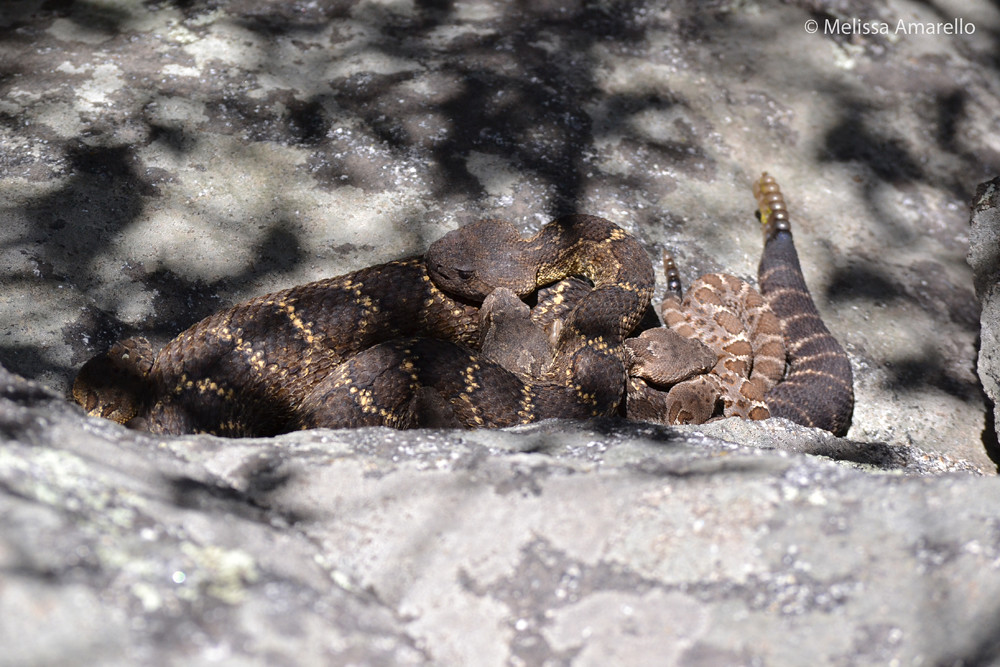
An adult male with several female and juvenile Arizona black rattlesnakes basking just outside their den.
Timber and Arizona black rattlesnakes are similar in many aspects of their behavior. Arizona blacks also den communally, although this behavior is not restricted to the northern part of their range as it appears to be in timber rattlesnakes [1,2]. Some female Arizona blacks use rookeries at or near their dens, although many nest alone.
So, are aggregations of Arizona black rattlesnakes related? Or like timber rattlesnakes, perhaps only aggregations of pregnant females and juveniles are related. Or maybe aggregations of Arizona black rattlesnakes are just random groups of unrelated individuals. This is one our research topics, which you can read more about here. Hopefully we'll be able to answer the above questions over the next couple years.
- Clark, R.W., W.S. Brown, R. Stechert, and H.W. Greene. Cryptic sociality in rattlesnakes (Crotalus horridus) detected by kinship analysis. Biology Letters rsbl20111217; published ahead of print February 22, 2012. doi:10.1098/rsbl.2011.1217
- Brown, W.S. 1993. Biology, status, and management of the timber rattlesnake (Crotalus horridus): a guide for conservation. Herpetological Circular 22.
Sunday, February 19, 2012

Cap Mama takes advantage of some rain to take a drink of water dripping off the rock above.
Drinking is a behavior rarely seen in wild snakes. In fact, some would say that snakes don't need to drink. While it is rare to see this behavior, snakes do drink and likely need water in addition to what they acquire from their food. How important drinking is to snakes became very clear to me one day in March 2006 (Repp & Schuett 2008). Despite cold, rainy, windy, and even snowy weather, we saw more than a dozen western diamond-backed rattlesnakes drinking rain and snow outside their dens!
Last summer was pretty dry at our field site; the monsoon did not amount to much. In the photo at the top of this post, you can see Cap Mama snagging a drink about nine days after giving birth. The following videos were taken by our time-lapse cameras while the snakes were still pregnant:
This is Cap Mama again, about a week before she gave birth. Shortly after the rain starts, she emerges and drinks rain as it falls on her body.
Meanwhile on the other side of this rock outcrop, another pregnant female (Stache) also sneaks out for a drink. Unfortunately there is some grass in the way, but you can still get an idea of what a drinking snake looks like.
For more information on drinking and water harvesting in snakes, check out this paper:
Repp, R.A. & Schuett, G.W. 2008. Western diamond-backed rattlesnakes, Crotalus atrox (Serpentes: Viperidae), gain water by harvesting and drinking rain, sleet, and snow. Southwestern Naturalist 53: 108–114.
Sunday, January 29, 2012
It is always a little sad to say goodbye to the rattlesnake families at the end of the nesting season. It’s a difficult time for the neonates (newborns); in this population they have less than a month to find their first meal and locate a safe place to spend the winter. That’s a tall order for a two week old snake. So when the little ones disperse from the nest, we can never be sure that we’ll see them again. Today, we share stories about some of the lucky (or skillful?) neonates that survived that first winter.

Eve (large brown female rattlesnake) nested with another female, Peach (not pictured), in 2010. Together they cared for about 10 neonates, although Eve was the one most often seen on the surface with the little ones. Above you can see Bozo basking with Eve in August 2010.

Fast forward to April 2011, when the rattlesnakes are emerging from their den. Here Eve is captured by our timelapse camera coming out to bask.
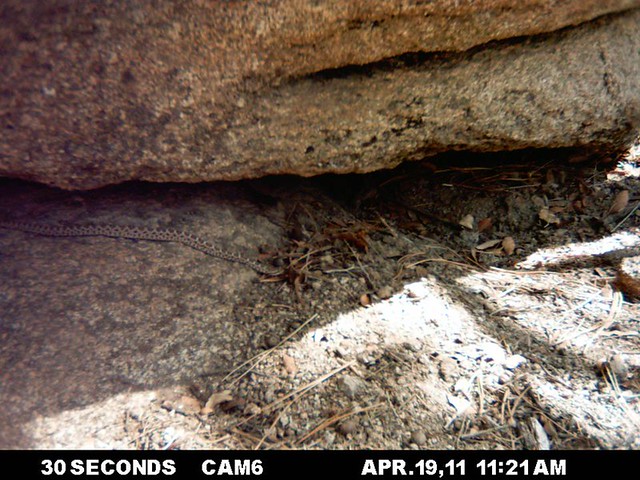
Bozo follows about 20 minutes later. They crawled onto a pile of leaves in the sun:
After basking a bit with Eve, Bozo gets restless and heads off camera. A little while later, Eve appears to notice he’s gone, searches for and finds his trail (note how her head is tapping the ground), and heads off in the direction he left.
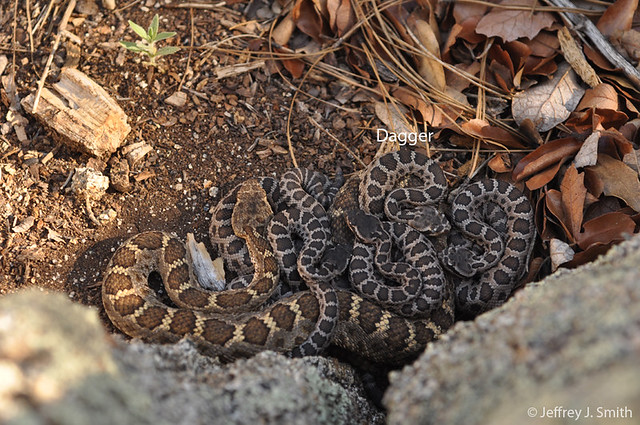
Another neonate from Eve and Peach’s nest we called Dagger. We haven’t thoroughly examined all the footage from the timelapse cameras, but so far, we have not seen Dagger at the dens in Spring 2011. So either we’ve missed him or he did not den with his nestmates, because….

Dagger was hunting near the dens in late August 2011. He hung around the area for at least a week, trying out several different spots to get a meal. Then on 1 September, our timelapse camera caught him crawling into the rear entrance of Cap Mama’s nest (she gave birth that day).

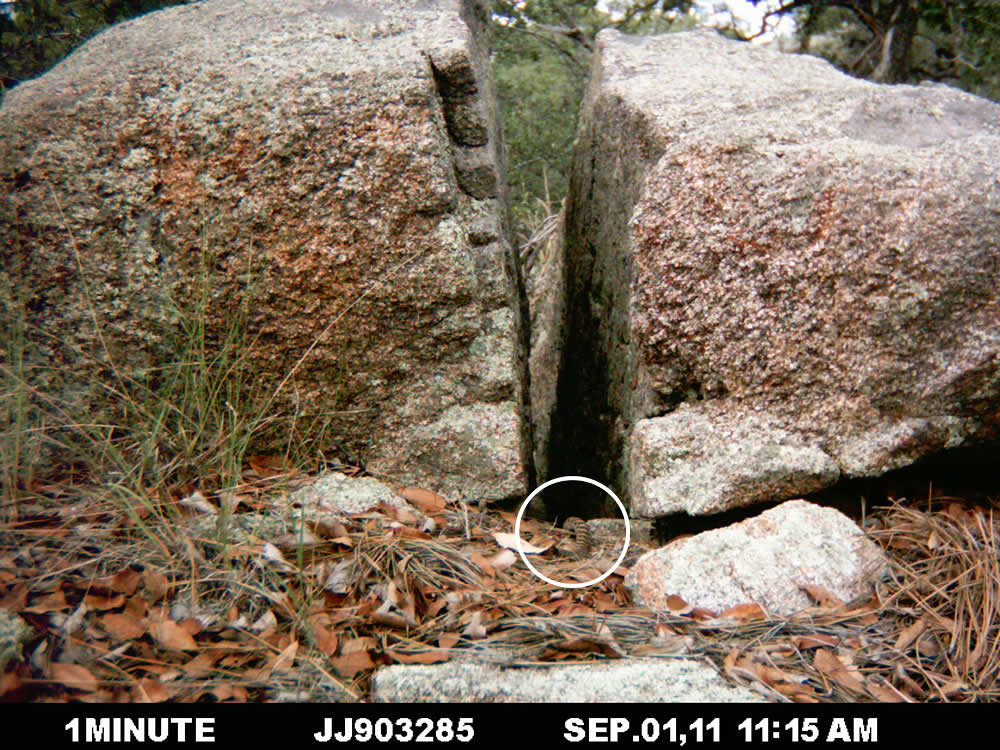
Unfortunately that is the only footage we have of Cap Mama's nest that day, so we don't know if Dagger interacted with her or the neonates.

The photo on the left is of Adam (neonate on left) and Woody (right), his mother. Woody's nest was farther away than most in 2010, about 150 yards from her den. Regardless, Adam found his way to the den where we saw him in April 2011 (photo on right). Our timelapse camera caught Woody and Adam as they basked together that day:

This is Devil Tail, who nested alone at her den in 2010. Shortly after she gave birth, a large male rattlesnake, who also dens here, visited and basked with the family:
Still image of the group:
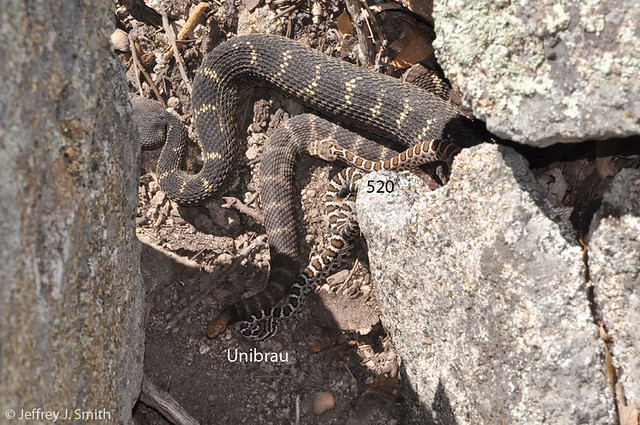
The adult male is the large black rattlesnake at the top of the image and Devil Tail is the smaller, brown adult (mostly her tail and rattle are visible). Both of the neonates pictured here were seen at the den the following spring (2011).
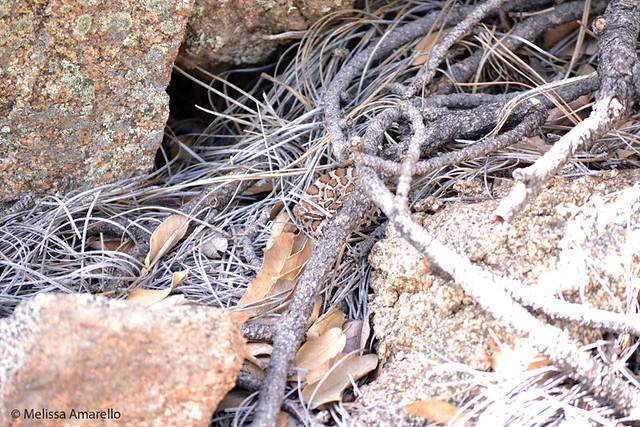
Above is '520' in April 2011. Hopefully he'll be adopted and named soon!
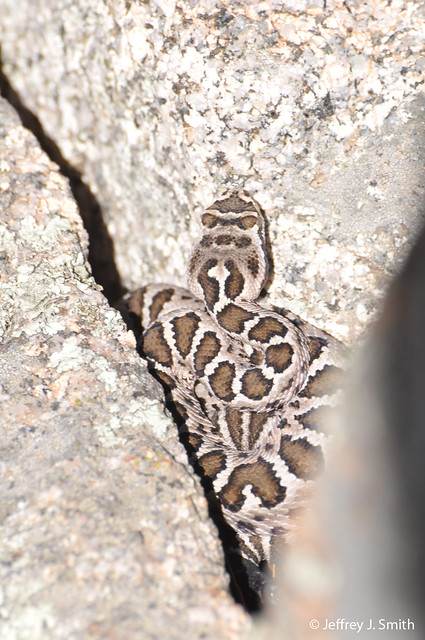
And this is Unibrau in April 2011. Unibrau was adopted by Bill Rulon-Miller - thanks!
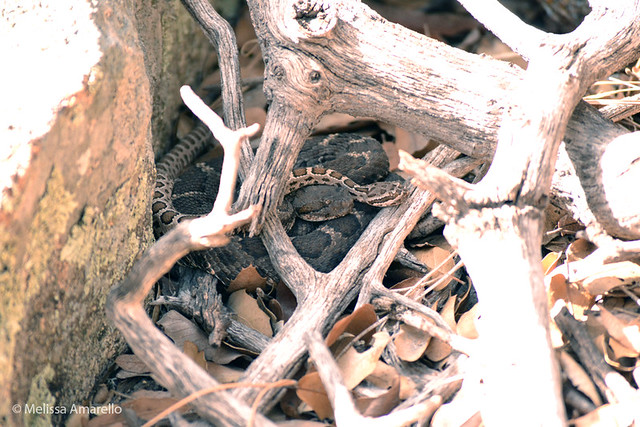
Barb, another of Devil Tail's neonates, is pictured here with Sigma in April 2011. Perhaps nesting right at the den increases your chances of surviving your first winter, because Devil Tail's kids seem to be doing pretty good!
If you enjoy reading these blog posts, please check out our project on RocketHub and support us financially or by spreading the word. We're raising funds to examine relatedness of this population of rattlesnakes, which will enable us to answer many questions our work has raised, including:
Are Peach and Eve, who nested together in 2010, sisters? Aunt and niece? Mother and daughter?
Was the male that visited Devil Tail the father of her neonates? Their uncle?
Supporting a research project might sound expensive, but it doesn't have to be. Through RocketHub, you can chip in as little as $5 to help us out. So skip one beer/wine/starbucks and support some cool snake research instead! Plus, you can get some cool snake stuff: rattlesnake photos, greeting cards, or adopt your very own social rattlesnake!
OK, maybe you don't have $5. But, it only takes a minute to share the link to our blog or RocketHub project on Facebook or Twitter. You have a minute, don't you? Thanks for whatever you can do to support SocialSnakes!
Monday, December 19, 2011
Are snakes social? YES! Do snakes live in groups? SOMETIMES! Are these groups of snakes extended families? Help us find out!
As a reader of this blog, you already know that rattlesnakes are quite gregarious. Their social lives are complex; they recognize and preferentially associate with their siblings, care for their kids, and even help care for their neighbor’s kids. But the big question remains unanswered.
Many of us who monitor rattlesnake dens have speculated that they are composed of closely related individuals. Our goal is to explore this idea by examining relatedness with microsatellite DNA markers. With your help, we will find out if dens really are a rattlesnake family reunion. Our research might reveal a previously undocumented, complex social system in snakes and promote snake conservation by highlighting some very human-like behaviors.
You know you're curious about the relatedness of the snakes you've been reading about here! Check out our project on RocketHub.
And spread the word! This can be just as helpful as a financial contribution.
Friday, December 16, 2011
Squirrels and rattlesnakes have a complicated relationship. Some squirrels have developed resistance to rattlesnake venom so that an adult squirrel can survive a rattlesnake bite. Juvenile squirrels cannot, so they are often still prey to rattlesnakes. Because of their resistance, adult squirrels will confront rattlesnakes that wander near their colonies and sometimes even kill them!
For more information on rattlesnake-squirrel interactions, check out research from Rulon Clark’s lab and his student Bree Putman’s blog. Now on to Sigma’s story…
We first met Sigma on 23 April 2011 when she was basking near her den. She was named for one of her many weird blotches that is shaped like the Greek letter.
 Sigma and Barb, 24 April 2011. Barb was born here, to another female (Devil Tail), the previous September (2010).
Sigma and Barb, 24 April 2011. Barb was born here, to another female (Devil Tail), the previous September (2010).
6 August: We return to the dens and find Sigma at large rock near her den that will be her nest site. Toward the end of her pregnancy, she settles on the west side of the rock as her main basking area, so we set up a timelapse camera there.
Between 3 and 4 September, the squirrel appears to be investigating the nest rock, but never when Sigma is on the surface.
On 5 September, Sigma and the squirrel meet:
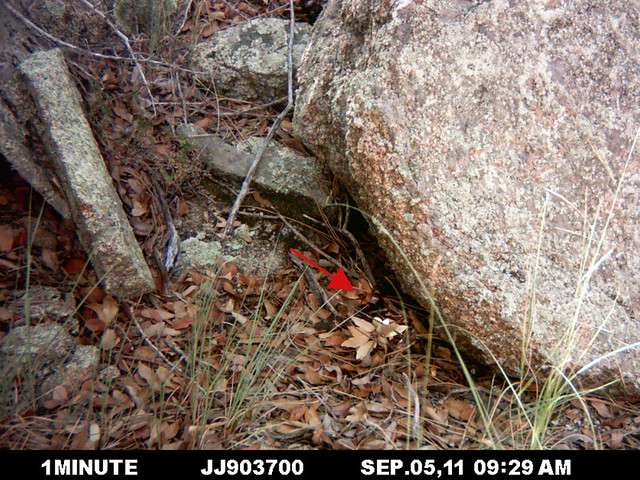 Sigma (at end of arrow) emerging for the first time that day
Sigma (at end of arrow) emerging for the first time that day
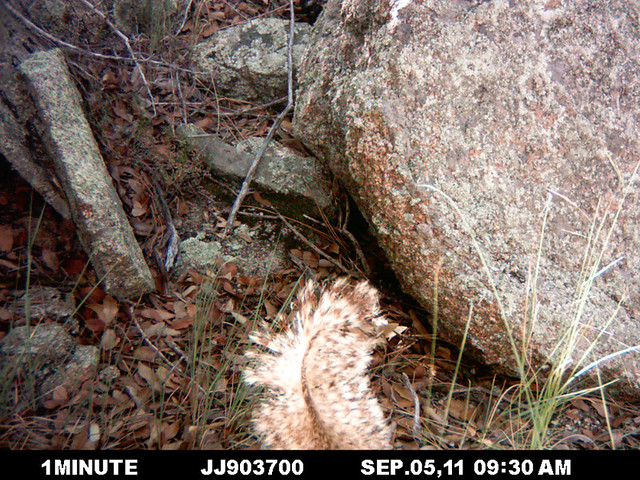 The squirrel confronts Sigma
The squirrel confronts Sigma
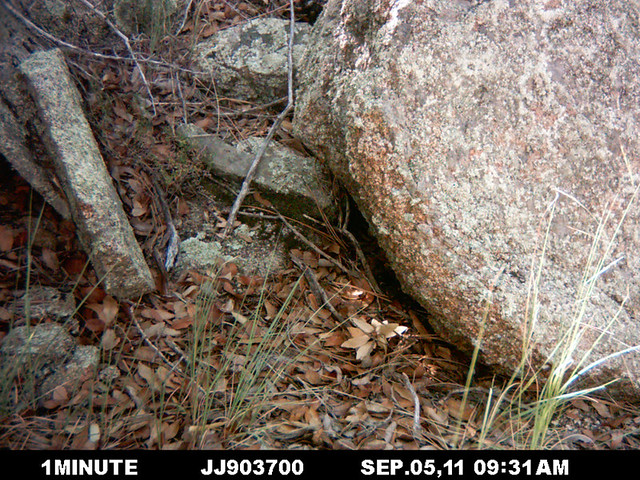 Sigma immediately retreats beneath her nest rock
Sigma immediately retreats beneath her nest rock
6 September: Sigma sticks her head out and looks around before emerging (like Cap Mama ). About an hour later, the first of her four neonates emerge from beneath the rock:
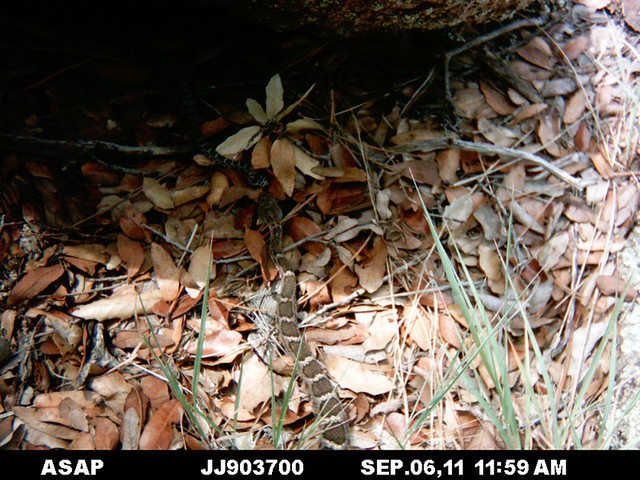
The following video captures Sigma’s family’s first day together (warning: its kinda long, 4 minutes). Watch for the squirrel’s appearance at 12:14PM.
The squirrel does not return (that we can see) the following day and the family spends most of it on the surface:
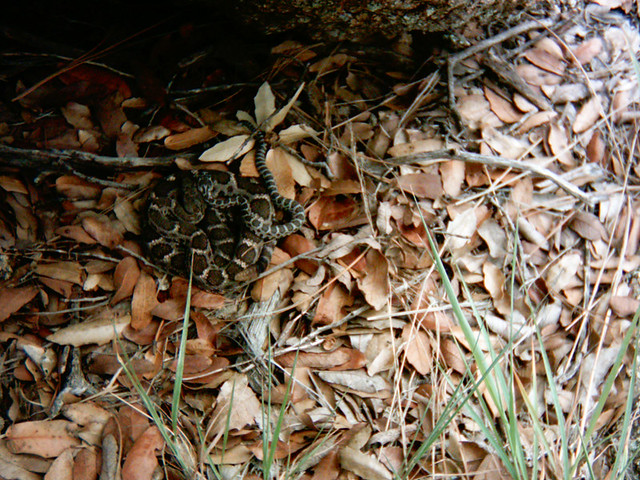
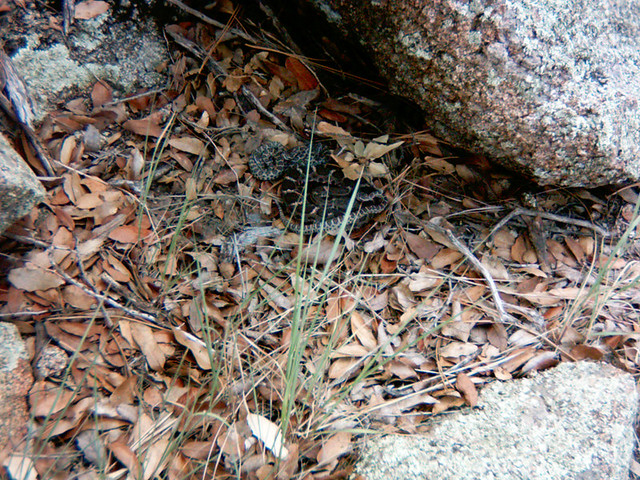
Timelapse video of 8 September:
What starts as a peaceful day for the family was rudely interrupted by the squirrel at 11:27AM. Just before the squirrel appears in the video, Sigma turns and assumes an S-coil defensive posture typical of rattlesnakes:
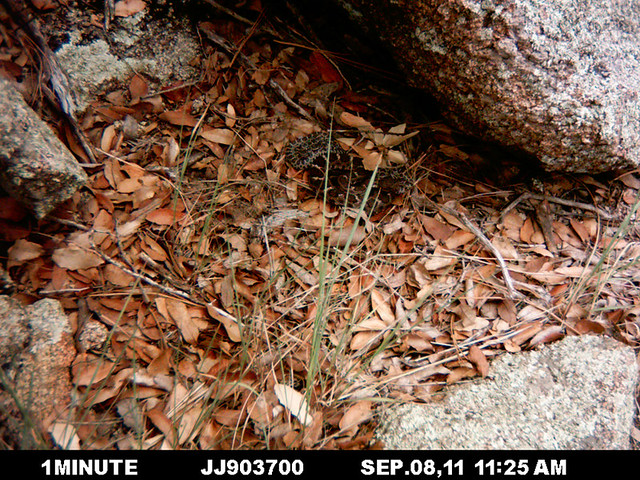 Sigma at rest with her family
Sigma at rest with her family
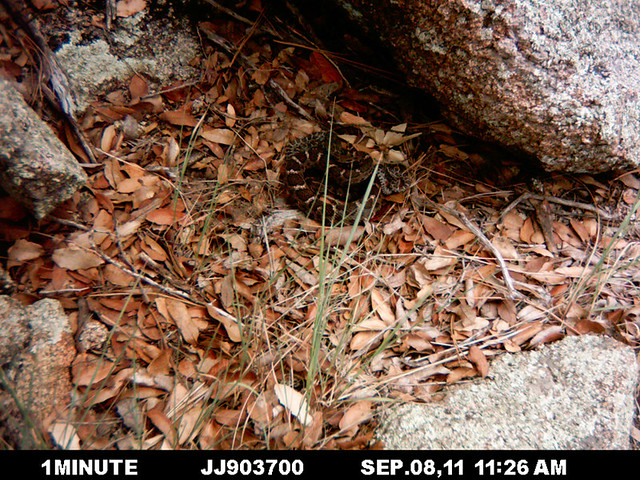 Sigma turns, expands her body to look as large as possible, and assumes a ready-to-strike (S-coil) defensive posture.
Sigma turns, expands her body to look as large as possible, and assumes a ready-to-strike (S-coil) defensive posture.
What you can’t see in the video was captured by our overhead camera; Sigma is posturing to the squirrel just off screen:
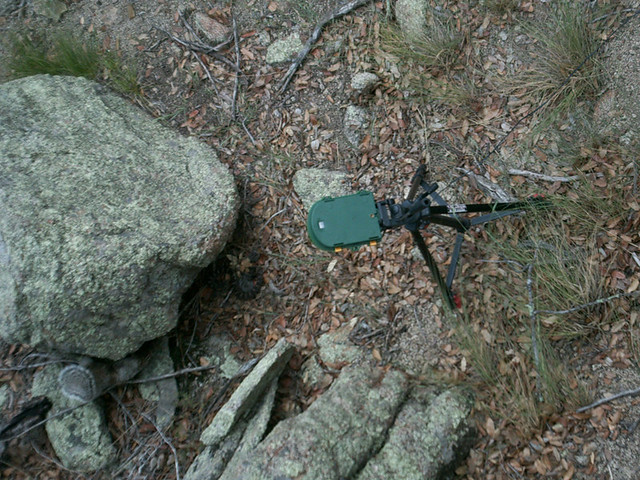
The family immediately disappears; Sigma reemerges only after the squirrel is gone. The first neonate to emerge is quickly chased back under the nest rock by the squirrel (~11:54AM–12:01PM in the video).
9 September: After the squirrel interactions, the family seems to spend much less time on the surface (at least where the cameras can see). We recorded only one additional, indirect, interaction between Sigma and the squirrel:
As it often did when there weren’t snakes visible, the squirrel appears to be looking underneath the nest rock. Sigma returns, takes on the familiar defensive posture and appears to be rattling – although it’s difficult to be certain because the timelapse photos were taken at one-minute intervals.
Our camera continued to record at this location until 18 September and the squirrel returned about every other day, usually looking underneath the nest rock. Sigma and her four neonates were never seen together again, but we cannot say if they changed their behavior or if one or more neonates were injured or killed. One limitation of remote photography is that our knowledge is limited to what happened in view of the camera. However, it is unlikely that any of these squirrel-rattlesnake interactions would have occurred if a human observer was present. We never saw anything like this when we monitored rattlesnake families in person – have you?
Friday, December 9, 2011
You didn't think that Arizona black rattlesnakes were the only ones to take care of their kids, did you?

In a recent post on the Field Herp Forum, my friend Young Cage describes a series of observations of a family of Mexican West Coast Rattlesnakes (Crotalus basiliscus) . Young is an excellent photographer, so the post is worth checking out just to look at the pictures.









